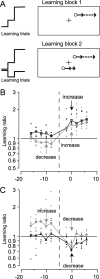Spatial generalization of learning in smooth pursuit eye movements: implications for the coordinate frame and sites of learning
- PMID: 12040080
- PMCID: PMC2548309
- DOI: 10.1523/JNEUROSCI.22-11-04728.2002
Spatial generalization of learning in smooth pursuit eye movements: implications for the coordinate frame and sites of learning
Abstract
We have examined the underlying coordinate frame for pursuit learning by testing how broadly learning generalizes to different retinal loci and directions of target motion. Learned changes in pursuit were induced using double steps of target speed. Monkeys tracked a target that stepped obliquely away from the point of fixation, then moved smoothly either leftward or rightward. In each experimental session, we adapted the response to targets moving in one direction across one locus of the visual field by changing target speed during the initial catch-up saccade. Learning occurred in both presaccadic and postsaccadic eye velocity. The changes were specific to the adapted direction and did not generalize to the opposite direction of pursuit. To test the spatial scale of learning, we examined the responses to targets that moved across different parts of the visual field at the same velocity as the learning targets. Learning generalized partially to motion presented at untrained locations in the visual field, even those across the vertical meridian. Experiments with two sets of learning trials showed interference between learning at different sites in the visual field, suggesting that pursuit learning is not capable of spatial specificity. Our findings are consistent with the previous suggestions that pursuit learning is encoded in an intermediate representation that is neither strictly sensory nor strictly motor. Our data add the constraint that the site or sites of pursuit learning must process visual information on a fairly large spatial scale that extends across the horizontal and vertical meridians.
Figures










Similar articles
-
Postsaccadic enhancement of initiation of smooth pursuit eye movements in monkeys.J Neurophysiol. 1998 Apr;79(4):1918-30. doi: 10.1152/jn.1998.79.4.1918. J Neurophysiol. 1998. PMID: 9535958
-
Saccades exert spatial control of motion processing for smooth pursuit eye movements.J Neurosci. 2006 Jul 19;26(29):7607-18. doi: 10.1523/JNEUROSCI.1719-06.2006. J Neurosci. 2006. PMID: 16855088 Free PMC article.
-
Enhancement of multiple components of pursuit eye movement by microstimulation in the arcuate frontal pursuit area in monkeys.J Neurophysiol. 2002 Feb;87(2):802-18. doi: 10.1152/jn.00409.2001. J Neurophysiol. 2002. PMID: 11826048 Free PMC article.
-
The representation of time for motor learning.Neuron. 2005 Jan 6;45(1):157-67. doi: 10.1016/j.neuron.2004.12.017. Neuron. 2005. PMID: 15629710
-
Linked target selection for saccadic and smooth pursuit eye movements.J Neurosci. 2001 Mar 15;21(6):2075-84. doi: 10.1523/JNEUROSCI.21-06-02075.2001. J Neurosci. 2001. PMID: 11245691 Free PMC article.
Cited by
-
Acquisition and generalization of visuomotor transformations by nonhuman primates.Exp Brain Res. 2005 Feb;161(2):209-19. doi: 10.1007/s00221-004-2061-4. Epub 2004 Oct 5. Exp Brain Res. 2005. PMID: 15480596
-
The role of the frontal pursuit area in learning in smooth pursuit eye movements.J Neurosci. 2004 Apr 28;24(17):4124-33. doi: 10.1523/JNEUROSCI.0172-04.2004. J Neurosci. 2004. PMID: 15115807 Free PMC article.
-
A population decoding framework for motion aftereffects on smooth pursuit eye movements.J Neurosci. 2004 Oct 13;24(41):9035-48. doi: 10.1523/JNEUROSCI.0337-04.2004. J Neurosci. 2004. PMID: 15483122 Free PMC article.
-
Orienting Gaze Toward a Visual Target: Neurophysiological Synthesis with Epistemological Considerations.Vision (Basel). 2025 Jan 14;9(1):6. doi: 10.3390/vision9010006. Vision (Basel). 2025. PMID: 39846622 Free PMC article. Review.
-
Serial linkage of target selection for orienting and tracking eye movements.Nat Neurosci. 2002 Sep;5(9):892-9. doi: 10.1038/nn897. Nat Neurosci. 2002. PMID: 12145637 Free PMC article.
References
-
- Carl JR, Gellman RS. Human smooth pursuit: stimulus-dependent responses. J Neurophysiol. 1987;57:1446–1463. - PubMed
-
- Ferrera VP, Lisberger SG. Neuronal responses in visual areas MT and MST during smooth pursuit target selection. J Neurophysiol. 1997;78:1433–1446. - PubMed
-
- Gattass R, Gross CG. Visual topography of striate projection zone (MT) in posterior superior temporal sulcus of the macaque. J Neurophysiol. 1981;46:621–638. - PubMed
Publication types
MeSH terms
Grants and funding
LinkOut - more resources
Full Text Sources
